Dear Friends
The horses have run ranch-rampant. But they’re on vacation at this time of year. They’ve put their time in on the range over the summer season. There, they worked off fat and built muscle mass from carry rider and camp gear over nearly a 1000 miles during the grazing tour. But that’s all over; shoes are off, and hair grown thick. We still use them to gather cattle on sort days and feed hay with the massive drafts.
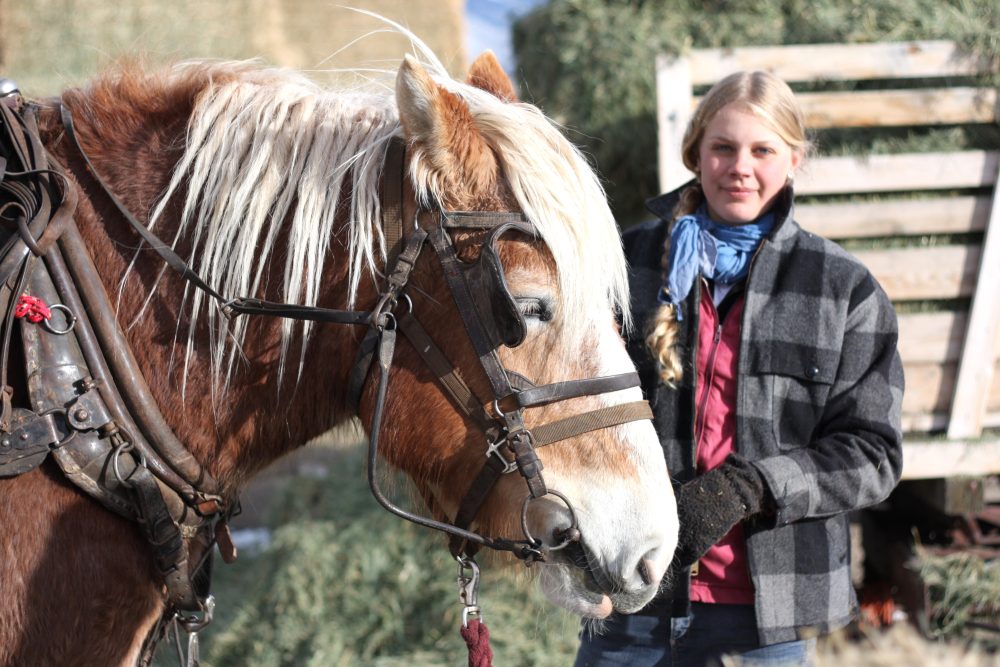
The horse cavvy ranges over 100s of acres on the ranch. Sometimes, at night when the moon is bright like it was last night, I can hear the rustle and thump of horses running through deep snow. Was it a lion that they spotted? A wolf on the big meadows? Only they could tell. They can feed themselves though the white, so maybe they were just moving briskly off to new grass.
Unlike cattle, they’ll use their feet to dig snow, and as a result, we only have to feed the oldest ones, whose legs get tired from digging. Once there to the grass level, they will eat the plant close to the ground with their front teeth. Cattle can’t do this, and use their tongues to eat, as they have nothing but gum on the top and front of their mouth.
Yesterday, while checking horses, I noted feet on the heavy draft horses. We keep them barefoot all year, as even in their working time of winter, they get better traction without shoes than with them. Plate-smooth shoes become ice skates on ice or even frozen mud, and are a wreck that is easily averted by keeping them barefoot.
We’ll be hitching them up soon to pull a hay wagon loaded with 4-6000 pounds of hay for feeding the beeves. We have three big horses that we can rotate through these chores, and they save us from starting an engine on a cold day. Even when it’s cold enough to congeal motor oil and our diesel pickups must be plugged in to crank the engine, we know the horses always start. Fact is that they rather enjoy the warm up of pulling the feed wagon. They’ll proudly hold their heads high and flare their nostrils as we get started.
The first few times in feeding season is always a bit of rodeo as they settle down into their tasks. The team prances around the hay stack yard at a near gallop the first time we hook up; sometimes they rear up on hind legs and paw the air in full harness while hooked to the hay wagon. I don’t let anyone ride with me on the wagon those first few times until they settle down. I’ll drive them with the long leather lines in my hand, talking gentling words to them, while watching every straining piece of leather for flaws as they lean in and begin running with their heavy load. I know they are cognizant of my conversation with them because their ears swivel backward to hear my words, especially when I speak their names.
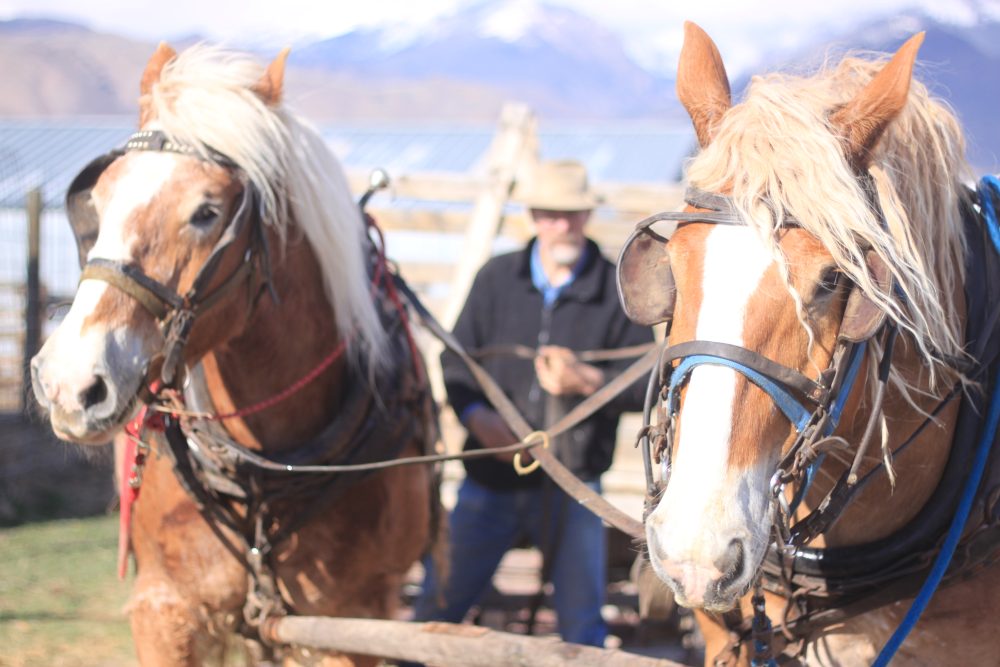
When one is misbehaving or getting a little too excited, I’ll talk to him or her in particular to calm them down a notch. After a few laps around the hay stacks, they get their feet under them and settle down to a winter’s work. Then it is just the quiet jingle of buckles against leather harness on the way to the field where the beeves await, and finally the sound of a quiet communal crunching as the beeves happily descend upon the green grass hay. When feeding with an experienced team, one wrangler can pull the whole job. The undulating sea of beeves will part as the horses are guided solely by the voice of the driver, lines tied off to the front of the wagon. As the horses patiently pull the wagon, the wrangler is able to grab a pitchfork and lay the hay down in a neat windrow for the beeves to scoop up with their tongues.
I recall Pet and Pat, a mother and daughter heavy horse team I had some 20 years back on our last ranch. They really had the feeding job down. I could talk them through the whole process, while I loaded hay on the wagon, jumped off to get gates, and then headed out to the meadows where I forked hay off the back of the wagon. My kids were tiny tots back then, so the chores belonged entirely to me and my hardworking equine partners.
Those mares were not always like that, though. They, too, needed time to learn the task before them. Pat, the daughter, was the trouble. She just did not trust me, even though her mother did completely. Pat would occasionally lose it and run (they are prey animals, descended from their wild Asian steppe ancestors). It wasn’t until the next year when I camped with her and Pet alone in the high timber and used them as a logging team—living and working in the wilderness—that she learned to trust me because we had to all lean heavily on each other in the dangerous, steep and rocky terrain. We skidded many big logs out over several months that I felled into the dense underbrush, choked up with an additional layer of a hundred years of bug-killed downfall.
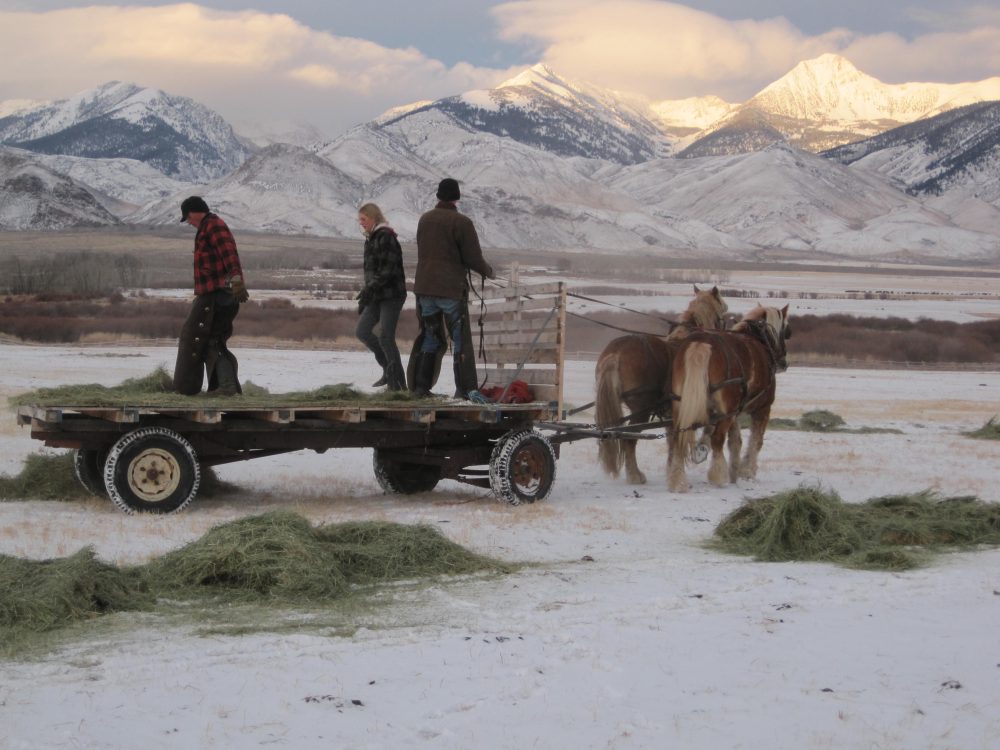
Even before logging, she was coming along, albeit slowly. After all, we were getting the cattle fed every day. I calmly harnessed and hitched them up one morning, and had the hay wagon parked right in front of a heavy wooden gate, so if they had an inkling to move on out, they had nowhere to go. Slightly nervous Pat quietly pawed the ground with her dinnerplate-sized front feet as I hooked them to the wagon. It had just snowed, and she was making a little pile of the white stuff under her. Pet, her mom, just looked on, disinterested. No pawing the ground for her. As I was hooking up the heavy leather trace strap chains to the doubletree, I noticed that my front wheel on the hay wagon was low on air—nearly flat. I needed to fix it, because the heavy load of hay already on the wagon would certainly cause it to blow a bead and go flat once we got underway. In the new snow, it would make the pull pretty unwieldy, even for the big mares.
In one of those light bulb moments, I ran to the shop and grabbed the suitcase pressure tank. Portable air! What a concept! I carried the tank to the wheel, crawled under the front of the wagon, pulled the hose and popped it on the valve stem. Upon the quick hiss of starting the air, Pat, still pawing the ground, looked back a little askance with eyes wide. After all, it was right behind her, but she had nowhere to go with her nose only 3 feet from the massive lodgepole pine gate. The gate was over 5 feet high and was comprised of 4″ thick rails, and was solid. No worries.
I spoke to her quietly as I checked the pressure. Almost there. I popped the hose back on the valve stem with another snappy hiss. On this one, she blew some snot out of flared nostrils while rocking the heavy wagon, getting her mom’s attention. I raised my voice a little with a “whoa, Pat, easy girl, eaaassssyy.”
Very close on the air now. Just a little too much sidewall swell for my comfort, though. I popped the hose back on the valve stem. It was enough. What I mean to say is that it was enough for Pat. She was finished with that hissing nonsense, once and for all. Maybe she was having a little PTSD from a rattlesnake she met as a young’un on the ranges where she was raised. Who knows, but that last snappy hiss sent her straight into orbit.
With a tremendous surge, she lunged forward in her collar. The harness leather went tight as a guitar string and transferred a thousand foot pounds of kinetic energy to the doubletrees. The snowbound wheels snapped loose, and mild mannered mom Pet found herself forced to make a split second decision of go or be gone over.
She chose go. With the explosive thrust of both of them forward, they put their heads low and smashed into the 4″ rails and blew them apart like matchsticks. Meanwhile, I found myself somehow translated from underneath to the top and front of the hay wagon with lines in hand, put there by the reflex action of muscle and mind memory, trying to control them by bit pressure.
But the die had been cast, and we were going home! I ducked under the shrapnel of splintering gate members, and hung on to lines and wagon front. At full gallop we careened over the hill and through the wood at a literally breakneck speed. My plaintive cries of “whoa!” were lost in the wind of forward momentum.
Home was the corrals and barn down by Agency Creek. As we crested the hill, I realized the sum of all fears: the even larger gate to the corrals was swung and latched closed. We made that one extra secure because of the massive bulls we kept in there on occasion. The bull’s pain tolerance and brute bulldozer strength necessitated a fortress-like design.
Surely they will stop, I thought. My beautiful Belgians. The thought of stopping became delusional as we charged down the hill and I realized that physics was against us. The hill caused us to pick up speed, going from full gallop to dead run. The gate came on fast. As I watched them put their heads down, bracing for the impending crash (they have thick foreheads), I got down on my knees to shield myself from debris behind the front headache rack (good name) on the wagon.
Gate number two exploded. I was instantly covered with huge splinters of lodgepole pine as I felt our speed suddenly slow. When I opened my eyes, we were through, and rolling to a stop in the corrals. Home. I let the lines go slack. The mares were done running.
They stood, shaking and breathing heavily. I jumped off my crumpled wagon, and surveyed their injuries. Amazingly, there were only a few minor scrapes and cuts. No streaming blood or hanging flesh. They stood calmly, although still obviously shaken while catching their breath and allowed me to pick out splinters. I was shocked. Their faces were fine. The harness on their headgear seemed to have taken most of the beating, as it was busted or torn in a number of places.
I knew we had to end on a good note, and those cattle still needed fed, so I let them catch their breath while I pulled some debris away from my destroyed gateway. There would be no repairing it. I patched their driving gear and harness back together with some baling twine, jumped aboard, and talked to them quietly, as they stood at attention and then slowly stepped forward. They hesitated a little at the blown out gate, as if to marvel at the damages, then off we went to feed cows as if nothing happened. No harm done, to them at least.
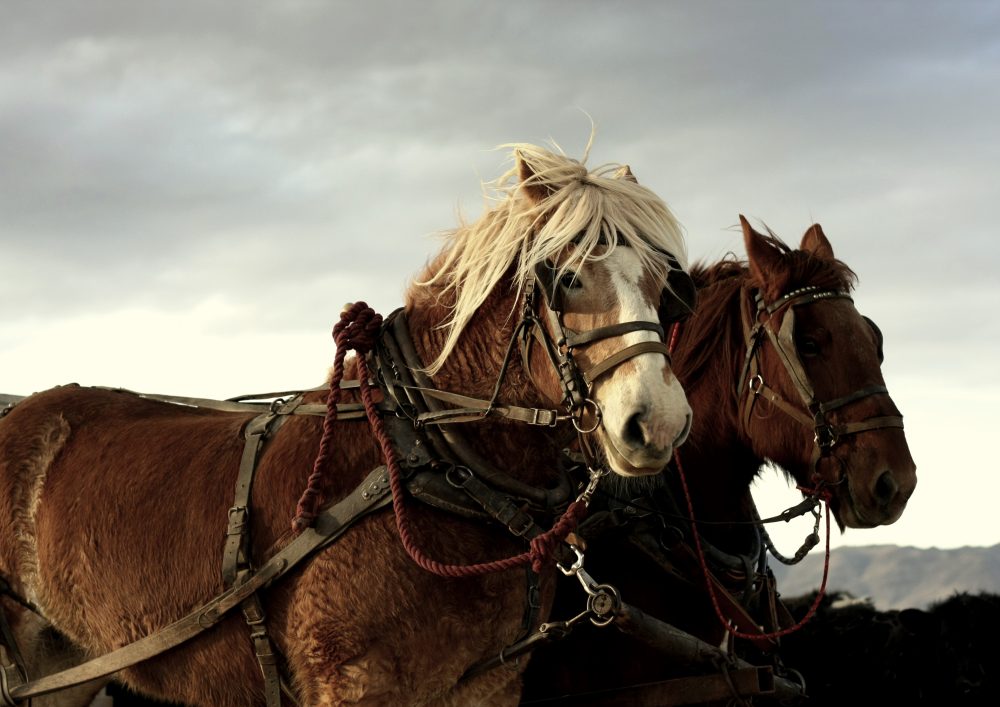
I worried about their minds more than their bodies. As I said above, that mare Pat did end up trusting me sometime after that incident, but only after we had put some more miles under us together. My mind, however, did get changed that day. The long route to success, like taking gear off and unhooking horses, in this case, would have been a much shorter one in terms of showing her I was trustworthy.
That is a case in point that we revisit often. We’ve been at this business of raising grass fed beef for over 29 years. There are many folks we see trying to fast track their grass-fed beef process, from raising beeves on farm residue instead of carefully tended pasture to short-cutting approaches in processing. Sure, ours has been a long road, fraught with obstacles and hard knocks along the way, but we believe it’s been worth it. Why?
Because the result is this: Alderspring is consistently the very best beef we have ever eaten. I hope you agree. Time is the best teacher, and we’re long students. The land and the soils and the flavors that come from it are still building, expressing, increasing.
I don’t think we’ll ever graduate, unfortunately. But I’m thinking that’s just right.
Happy Trails. -Glenn
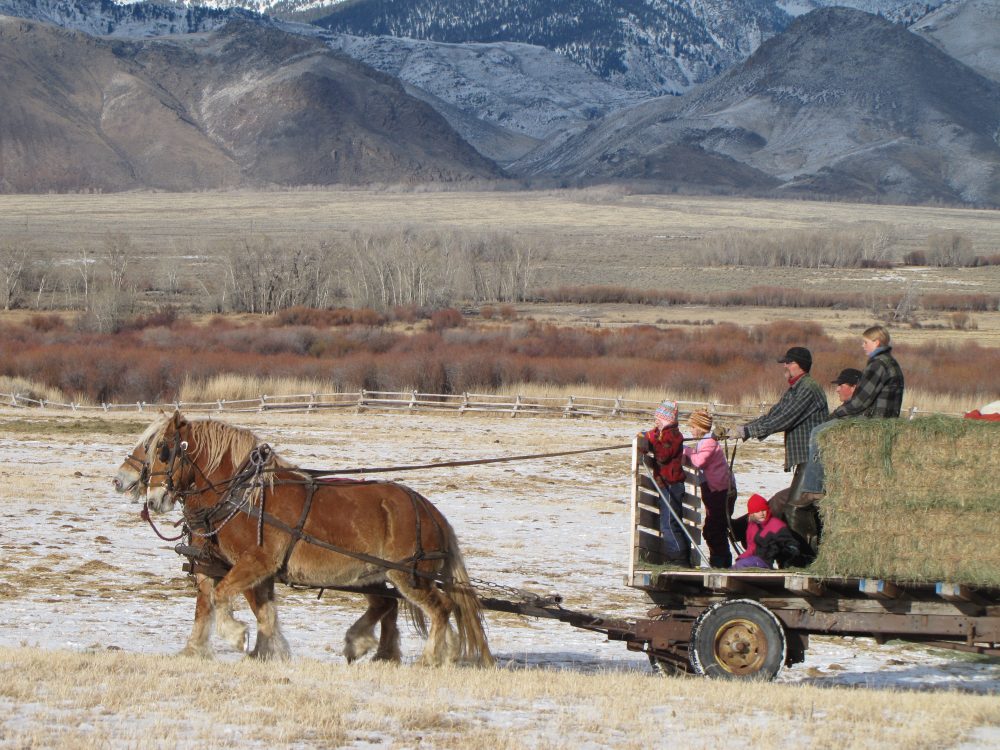

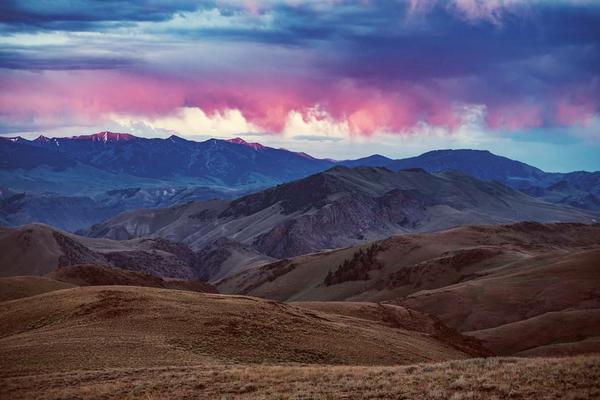
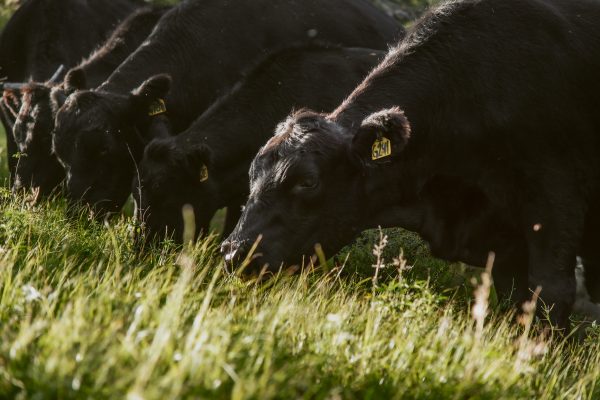


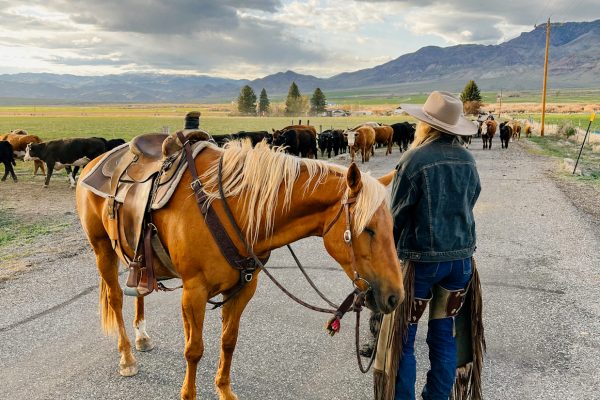
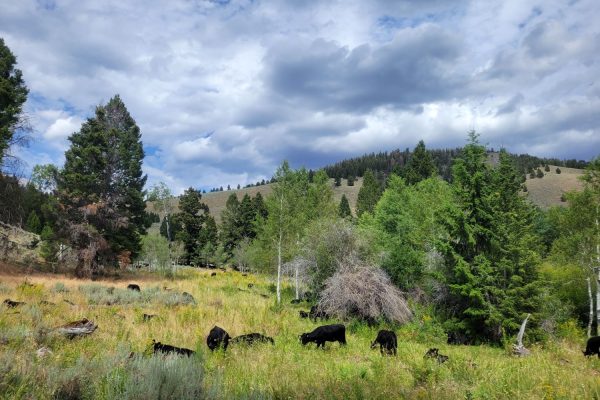
Deb Olsen
Your stories always play in my mind like a good movie, you never think of all of the things that can happen and I can’t imagine how scary it is sometimes. Yes your beef is truly the best of the best but it’s due to all of your hard work invested. I learn to appreciate the meals you put on my table and every time I bless our meal I pray you too are blessed for helping put it there with your hard work and dedication.
MICHELLE
That sounds like a heart pumping adventure! It was such fun to read. They are mighty creatures and was glad to hear neither the two legged or 4 legged animals were hurt. 🙂
Marcia Boettcher
Another “on the edge of my seat” read! I agree with what Deb Olsen said above, back in 2021! Thank you Alderspring Ranch! God bless and keep.
Patty
Great story! I always wanted to be a cowgirl so your photos and stories allow me to ‘live’ my dream! Your daughters are truly blessed to have such loving, hardworking, dedicated parents. Thank you!!